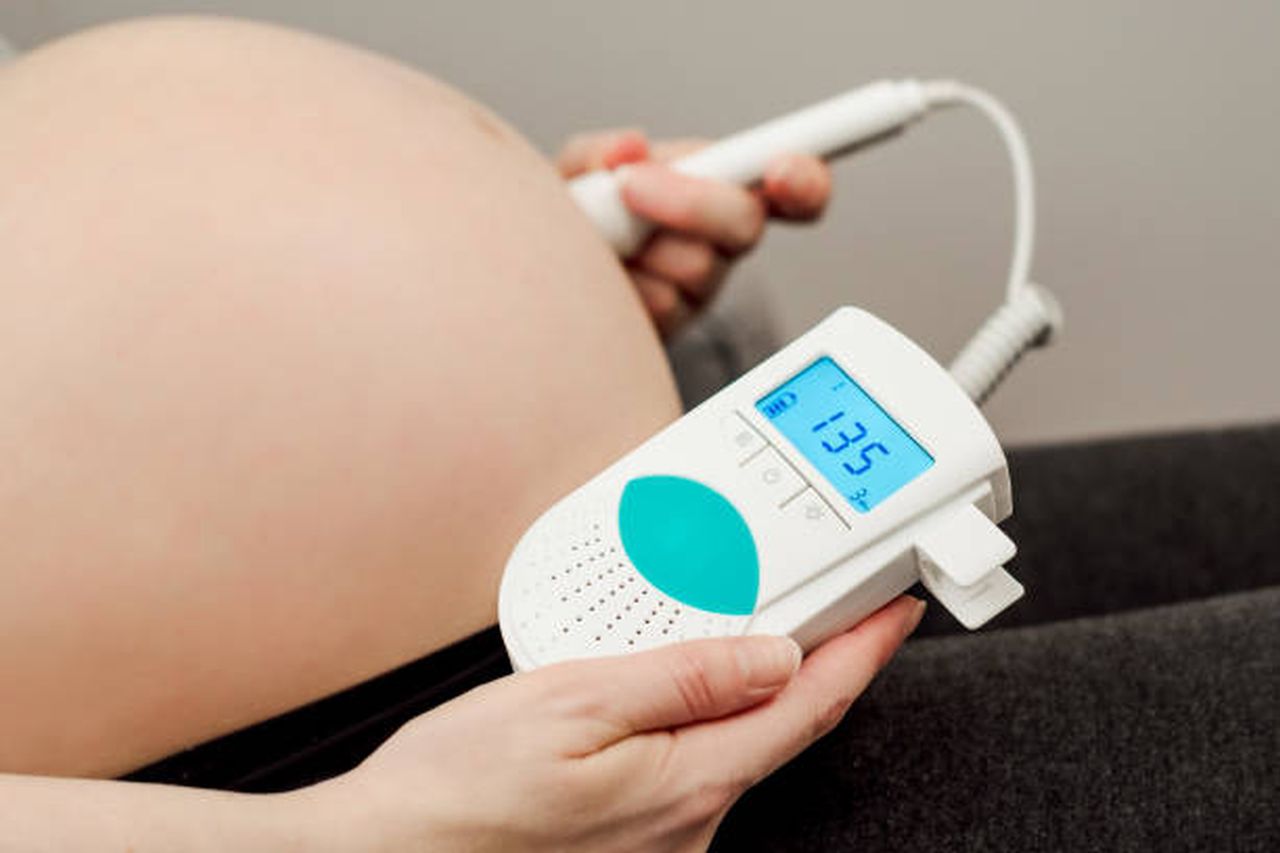If a pregnant woman's diabetes is not effectively managed, the developing fetus could be exposed to dangerously high blood glucose levels.
Make sure your diabetes is under control before, during, and after pregnancy. If blood sugar levels are allowed to become too high during pregnancy, the baby could be harmed before, during, and after delivery.
Fetal insulin production is increased when maternal diabetes is not well managed because of the transfer of excess blood glucose to the foetus during pregnancy.
Congenital abnormalities involving the heart, spinal cord, brain, gastrointestinal tract, and urinary tract formation are more common in women with insulin-dependent diabetes.
During the first three months of pregnancy, when the baby's organs are still developing, women with gestational diabetes typically have normal blood glucose levels, unlike those with insulin-dependent diabetes.
Diabetic Pregnancy: What Does It Mean for the Baby?
Birth to a diabetic mother automatically labels the newborn as a diabetic child. When a mother has diabetes, her unborn child is at increased risk for complications.
High blood sugar is a hallmark of the disease diabetes (hyperglycemia). This has the potential to cause severe health issues in the long run.
Taking care of one's blood sugar levels reduces one's vulnerability to issues. In addition to taking medication, a healthy diet, frequent exercise, and monitoring blood sugar levels can help you control your diabetes.
Pre-gestational and gestational diabetes can increase the risk to an unborn child.
There are two forms of diabetes that can occur during pregnancy. They are:
Gestational Diabetes
A person with this condition does not have diabetes prior to becoming pregnant. Instead, it's something you get while you're pregnant. After giving birth, your baby will no longer have gestational diabetes.
In women who have never had diabetes before, pregnancy can bring on a condition known as gestational diabetes.
Pre-gestational Diabetes
This condition occurs when a woman already has diabetes before becoming pregnant. Type 1 or type 2 diabetes could be affecting you. Diabetes mellitus type 1 or type 2 is known as pregestational diabetes, and it is treated with oral hypoglycemic agents or insulin in pregnant women who have previously been diagnosed with the disease.
Diabetes type 1 patients lack the ability to produce insulin. However, insulin is required for the body to metabolise blood sugar. You will need to inject yourself with insulin.
Those who have type 2 diabetes are ineffective at using their own insulin. They may not have access to insulin or produce insufficient amounts. Therefore, you'll require insulin and/or medication to reduce your blood sugar levels.
Taking care of your blood sugar levels is crucial throughout pregnancy. There will be less of a chance of complications for your kid if you do this.
Be sure your baby has a comfortable night's sleep by browsing our selection of baby nursery bedding Manchester.
FAQS About Pregnancy & Diabetes
If a woman with diabetes keeps her blood sugar well controlled before and during pregnancy, she can increase her chances of having a healthy baby. Controlling blood sugar also reduces the chance that a woman will develop common problems of diabetes, or that the problems will get worse during pregnancy.
Most women with gestational diabetes can make it to their due dates safely and begin labor naturally. In some cases, though, gestational diabetes could change the way you feel or how your baby is delivered. Having gestational diabetes does not mean that you will have any change in delivery.
Because of the extra insulin made by the baby's pancreas, newborns may have very low blood glucose levels at birth and are also at higher risk for breathing problems. Babies born with excess insulin become children who are at risk for obesity and adults who are at risk for type 2 diabetes.
Eat plenty of fruit and vegetables – aim for at least 5 portions a day. avoid sugary foods – you do not need a completely sugar-free diet, but swap snacks such as cakes and biscuits for healthier alternatives such as fruit, nuts and seeds. avoid sugary drinks – diet or sugar-free drinks are better than sugary versions.
If you get less than 7 hours of sleep per night regularly, your diabetes will be harder to manage. Too little sleep can: Increase insulin resistance. Make you hungrier the next day and reduce how full you feel after eating.
What Are the Risks to a Baby Born to a Diabetic Mother?
When a woman is pregnant, she receives nourishment and hydration from the placenta. Additionally, it produces essential hormones for a safe pregnancy.
Some of these hormones can inhibit insulin's effects. Typically, this occurs between the twentieth and twenty-fourth week of pregnancy.
The placenta produces more of these hormones as the pregnancy progresses. For this reason, insulin production from the pancreas must be increased.
When the pancreas is functioning normally, it produces enough insulin. To the contrary, it causes diabetes in pregnancy if it doesn't.
The insulin requirements of a diabetic woman may also fluctuate during pregnancy. More insulin may be required for those with type 1 diabetes.
Some people with type 2 diabetes will require either the beginning of insulin treatment or an increase in their current insulin dosage.
There are several potential health issues for a baby born to a diabetic mother. These problems can arise at any time during and after pregnancy.
When blood sugar isn't effectively managed, complications can arise. For instance, if a mother's diabetes is not effectively managed, her unborn child may be at risk for developing high blood sugar.
All stages of pregnancy, labour, and the newborn period might be impacted.
Infants born to mothers with uncontrolled diabetes tend to be larger than average.
There's a chance this could make vaginal birth more challenging and raise the risk of nerve damage and other complications. Moreover, the rate of caesarean sections increases.
Babies with IDM are more prone to experience hypoglycemia (low blood sugar) soon after delivery and in the early days of life.
Because the mother's milk contains more sugar than the infant needs, this happens.
Insulin levels are abnormally high in them after delivery. Insulin reduces blood sugar levels. Babies' insulin levels may need several days to normalise following birth.
There is a correlation between the following and IDM status:
- Inability to take deep breaths because of immature lungs
- High Number of Red Blood Cells (polycythemia)
- A bilirubin concentration that is too high (newborn jaundice)
- Heart muscle thickens between the two main chambers (ventricles)
Miscarriage or stillbirth rates are increased if diabetes is not effectively managed.
When a mother has diabetes and her blood sugar isn't effectively managed, her unborn child is at a greater risk of having birth defects.
Who Is At Risk For Gestational Diabetes?
You're more likely to develop gestational diabetes if you have any of these conditions:
- Adults older than 25
- Weight problems and obesity
- Past history of pregnancy-related diabetes (gestational)
- History of diabetes in the family
- Have just given birth to a huge baby
- Suffer from a stillbirth
What Signs Should We Look for in a Newborn Baby When Mom Has Diabetes?
The following are risks to your unborn child during pregnancy:
Miscarriage, premature birth, and birth abnormalities. Women who have had diabetes in the past are more prone to experience these.
- Low oxygen levels
- Enlarged heart
- Low blood iron levels
- Poor nervous system development
- Poor lung development
- High blood pressure
- High blood sugar
- Stillbirth
There are risks that your newborn may experience the following issues:
- Dimensionally Large (macrosomia). Delivery complications are more common in newborns who are larger than average. Shoulder injuries fall under this category.
- Having a low blood sugar (hypoglycemia)
- Hypocalcemia is a lack of calcium in the blood.
- Anemia due to a lack of iron in the blood
- Having a lot of red blood cells and a blood that's too thick
- Intense bilirubin production due to RBC breakdown
- Premature birth
- Birth defects. The heart, blood vessels, brain, and spinal cord are the most common sites of attack.
- Heart Enlargement
- Complications with breathing
The issues have a long-term nature. Babies of diabetic mums are at increased risk for developing diabetes and obesity themselves.
When compared to other infants born after the same amount of time in the womb, this one tends to be somewhat bigger (giant for gestational age). On the other hand, the infant may be smaller than expected in some pregnancies (tiny for gestational age).
Some other symptoms could be:
- Rapid breathing, racing heart, and bluish skin (signs of immature lungs or heart failure)
- Irregular breathing, lack of energy, and a feeble cry
- Seizures (an indication of severe low blood sugar)
- Poor feeding
- Round, bloated cheeks
- Shivering or trembling soon after birth
- Jaundice (yellow skin colour)
How Do Doctors Determine If a Pregnant Woman Has Diabetes?
During pregnancy, you will have a test for diabetes.
Early in pregnancy, your doctor will examine risk factors for type 2 diabetes, such as obesity. At the initial visit to the doctor, he or she may want to do a few tests.
Tests and Exams
Before The Baby Is Born:
In the final stages of pregnancy, an ultrasound is used to measure the mother's uterus and assess the baby's progress towards the birth canal.
The amniotic fluid could be examined for signs of lung development. Although it's not common practice, if the due date wasn't established early in the pregnancy, this could be helpful.

Following the Newborn's Arrival:
As soon as possible after birth, the newborn's blood sugar will be measured, and subsequent measurements will be made at regular intervals until it is consistently normal. Expect this to take a few days at the very least.
The baby will be monitored for respiratory and cardiovascular issues.
If the newborn shows symptoms of jaundice, the bilirubin level will be tested sooner than usual before discharge.
The infant's heart may be measured with an echocardiography.
Between the ages of 24 and 28 weeks of pregnancy, you will have a test to see if you have gestational diabetes.
An oral glucose tolerance test is used for this purpose (OGTT). A woman's blood sugar after a sugar load is measured using an OGTT (glucose). One of the following exams, for instance:
One-step Test
You will receive 75 grams of glucose after fasting for 12 hours. After a certain length of time, your healthcare professional will check your blood sugar.
Two-step Test
You don't have to fast because you'll have access to 50 grams of glucose. After a predetermined amount of time, your healthcare professional will check your blood sugar.
An oral glucose tolerance test (OGTT) with 100 grams of glucose will be performed if blood sugar levels are high.
Baby nursery sets are available at My Baby Nurseries and can help you create the perfect space for your little one.
What Kind of Treatment Is There for Diabetic Mothers and Their Children?
Your doctor will keep a careful eye on you and the baby as the pregnancy progresses.
Additionally, you may be cared for by a diabetic pregnancy expert.
Maintaining healthy blood sugar levels is essential. Your baby will be safer if you follow these steps. It's likely that you'll need to do the following in order to manage your diabetes:
Be mindful of your blood sugar levels. Your doctor may recommend that you perform routine at-home glucose monitoring.
Get your insulin shots as directed. Depending on how far along you are in your pregnancy, your insulin dosage may alter.
You should be careful about your weight. If you're already overweight or obese, your doctor may advise you to maintain your current weight or even lose some.
How you handled your blood sugar in the final weeks of pregnancy and when you were giving birth will determine how you treat your baby.
Your child's symptoms, age, and overall health will all play a role in determining the best course of treatment. The severity of the ailment will also play a role.
Monitoring
Your infant's doctor may need to take blood. The levels of glucose, calcium, and other nutrients in your baby's blood will be measured.
This can be done by a heel stick, an arm needle, or an umbilical catheter (a tube inserted into the umbilical cord).
Glucose
One of the first things your infant may need to eat is a solution of glucose and water. Another option is to inject glucose into your baby's vein (intravenously or IV).
A medical professional will monitor your infant's blood sugar levels closely. You should do this in case your infant's blood sugar drops dangerously low.
Help With Breathing
Your infant may benefit from the use of oxygen or a breathing machine.
If your child was born with a disability or has sustained an injury, they may require special care. It's possible that your kid needs to see a doctor. The answer to this question is condition-dependent.
Can Diabetes During Pregnancy Be Prevented?
Your baby's risk factors may decrease if you take good care of your diabetes. Maintaining control of your diabetes can be accomplished with regular monitoring of blood sugar levels and the use of insulin in conjunction with a healthy diet.
Being diagnosed with gestational diabetes increases your chances of developing type 2 diabetes in the future. You will be tested for diabetes after giving delivery if you have gestational diabetes.
This is often done between 6 and 12 weeks after giving birth. Because of your risk, your doctor will keep you on diabetic screenings.
Your child should be checked for diabetes routinely by a medical professional after birth. Their risk of complications can be mitigated with prompt diagnosis and treatment.
Potential Dangers to the Unborn Child
In the following, we will examine some of the potential problems that can arise if diabetes is not controlled properly during pregnancy.
Excessive Birth Weight
Overly high glucose levels in the mother's blood can be detected by the developing infant's pancreas because of glucose's ability to cross the placenta.
Because of this, the infant's pancreas produces additional insulin to process the glucose.
Because of this, the infant runs the risk of putting on excess weight. Macrosomia describes this condition.
Babies weighing 9 pounds or more are at a higher risk of birth injury and the requirement for a caesarian section because they are more prone to get blocked in the delivery canal.

Hypoglycemia
Newborns of diabetic mothers are more likely to have hypoglycemia, or low blood sugar, in the hours and days following birth because their bodies are releasing too much insulin.
Since the newborn is still receiving an abundance of insulin even though it is no longer exposed to the mother's elevated glucose level, the baby's blood sugar drops dangerously low after birth. In cases of extreme hypoglycemia, the infant may experience seizures.
After birth, the newborn's blood sugar level is measured and, if it's too low, an intravenous glucose solution may be given.
Premature or Early Birth
When a pregnant woman has high blood sugar, she may go into labour and have her baby before her due date.
Sometimes a doctor will suggest an early birth because the baby has gotten too big.
Respiratory Distress Syndrome
Premature infants often have respiratory distress, or trouble breathing.
The baby's body may take longer to produce the surfactant necessary for lung development if it has too much insulin.
Until their lungs develop and strengthen, these infants need help breathing.
The risk of respiratory distress in newborns whose mothers have poorly controlled diabetes is higher than average, even if the infant is delivered on time.
Late-Onset Diabetes of the Type 2 Variety
Babies of mums whose gestational diabetes was not well managed are at a higher risk for obesity and type 2 diabetes themselves.
Treatment
Babies delivered to mothers with diabetes should have their blood sugar checked immediately after birth, even if they appear healthy.
Several measures are taken to guarantee the newborn's blood sugar level is adequate:
In moderate cases of low blood sugar, early breastfeeding may avert complications. However, if the baby's blood sugar drops in the first 8 to 24 hours, then formula may be necessary even if breastfeeding is the intended method of feeding.
When there is not enough breast milk, many hospitals now use a dextrose (sugar) gel inserted into the baby's cheek instead of formula.
Glucose (sugar) and water-based fluids are given intravenously to patients whose low blood sugar levels do not rise in response to meals (IV).
An umbilical (belly button) vein must be used to administer glucose-containing fluid to a critically ill infant for several days if the infant requires a high amount of sugar.
Occasionally, the infant may require assistance breathing or medication to manage additional diabetes-related complications. To lower elevated bilirubin levels, for instance, light treatment is used (phototherapy).
Outlook (Prognosis)
The majority of infants who experience symptoms will have them disappear within a few hours, days, or weeks. However, it may take a few months for an enlarged heart to improve.
Brain injury from low blood sugar levels is quite unusual.
Complications That Might Arise
Women with poorly managed diabetes have an increased risk of having a stillborn child. Birth abnormalities and other complications are also more likely to occur.
- Heart defects present at birth.
- Increased Bilirubin Level (hyperbilirubinemia).
- Undeveloped Respiratory System.
- Acute polycythemia of infancy (more red blood cells than usual). This may lead to hyperbilirubinemia or artery blockage.
- Syndrome with a small left colon. This leads to intestinal obstruction symptoms.
When It's Time to See a Doctor
Getting prenatal care on a regular basis during pregnancy will ensure that any signs of gestational diabetes are caught early.
Call your doctor immediately if you are pregnant and have uncontrolled diabetes.
Pregnant women who aren't already seeing a doctor for their condition should do so immediately.
Prevention
Pregnant women with diabetes require specialised care. Maintaining healthy blood sugar levels can avoid numerous health complications.
Infants at risk for developing health issues due to low blood sugar levels can be identified and treated early by careful monitoring in the first hours and days after delivery.
Conclusion
If a pregnant woman has diabetes, her unborn child could be exposed to dangerously high blood sugar levels. There are two types of diabetes that can occur during pregnancy - pre-gestational and gestational. After giving birth, your baby will no longer have gestational diabetes. There are several potential health issues for a baby born to a diabetic mother. For instance, if a mother's diabetes is not effectively managed, her unborn child may be at risk for developing high blood sugar.
Infants born to mothers with uncontrolled diabetes tend to be larger than average. When a mother has diabetes and her blood sugar isn't effectively managed, her unborn child is at a greater risk of having birth defects. There are risks that your newborn may experience the following issues:. Dimensionally Large (macrosomia) Delivery complications are more common in newborns who are larger than average. As soon as possible after birth, the newborn's blood sugar will be measured, and measurements will be made at regular intervals until it is consistently normal.
Your doctor will keep a careful eye on you and the baby as the pregnancy progresses. It's likely that you'll need to do the following in order to manage your diabetes. How you handled your blood sugar in the final weeks of pregnancy and when you were giving birth will determine how you treat your baby. Maintaining control of your diabetes can be accomplished with regular monitoring of blood sugar levels and the use of insulin in conjunction with a healthy diet. Newborns of diabetic mothers are more likely to have hypoglycemia, or low blood sugar, in the hours and days following birth.
Babies weighing 9 pounds or more are at a higher risk of birth injury and require a caesarian section because they are more prone to get blocked in the delivery canal. An umbilical vein must be used to administer glucose-containing fluid to a critically ill infant for several days if the infant requires a high amount of sugar. Infants at risk for developing health issues due to low blood sugar levels can be identified and treated early by careful monitoring in the first hours and days after delivery.
Content Summary
- If a pregnant woman's diabetes is not effectively managed, the developing fetus could be exposed to dangerously high blood glucose levels.
- Make sure your diabetes is under control before, during, and after pregnancy.
- If blood sugar levels are allowed to become too high during pregnancy, the baby could be harmed before, during, and after delivery.
- Taking care of one's blood sugar levels reduces one's vulnerability to issues.
- In addition to taking medication, a healthy diet, frequent exercise, and monitoring blood sugar levels can help you control your diabetes.
- Pre-gestational and gestational diabetes can increase the risk to an unborn child.
- There are two forms of diabetes that can occur during pregnancy.
- Therefore, you'll require insulin and/or medication to reduce your blood sugar levels.
- Taking care of your blood sugar levels is crucial throughout pregnancy.
- There will be less of a chance of complications for your kid if you do this.
- Be sure your baby has a comfortable night's sleep by browsing our selection of baby nursery bedding Manchester.
- Additionally, it produces essential hormones for a safe pregnancy.
- The placenta produces more of these hormones as the pregnancy progresses.
- To the contrary, it causes diabetes in pregnancy if it doesn't.
- The insulin requirements of a diabetic woman may also fluctuate during pregnancy.
- There are several potential health issues for a baby born to a diabetic mother.
- These problems can arise at any time during and after pregnancy.
- When blood sugar isn't effectively managed, complications can arise.
- When a mother has diabetes and her blood sugar isn't effectively managed, her unborn child is at a greater risk of having birth defects.
- The following are risks to your unborn child during pregnancy: Miscarriage, premature birth, and birth abnormalities.
- Delivery complications are more common in newborns who are larger than average.
- Babies of diabetic mums are at increased risk for developing diabetes and obesity themselves.
- In the final stages of pregnancy, an ultrasound is used to measure the mother's uterus and assess the baby's progress towards the birth canal.
- Although it's not common practice, if the due date wasn't established early in the pregnancy, this could be helpful.
- As soon as possible after birth, the newborn's blood sugar will be measured, and subsequent measurements will be made at regular intervals until it is consistently normal.
- The baby will be monitored for respiratory and cardiovascular issues.
- Between the ages of 24 and 28 weeks of pregnancy, you will have a test to see if you have gestational diabetes.
- An oral glucose tolerance test is used for this purpose (OGTT).
- An oral glucose tolerance test (OGTT) with 100 grams of glucose will be performed if blood sugar levels are high.
- Your doctor will keep a careful eye on you and the baby as the pregnancy progresses.
- Additionally, you may be cared for by a diabetic pregnancy expert.
- Monitoring Your infant's doctor may need to take blood.
- The levels of glucose, calcium, and other nutrients in your baby's blood will be measured.
- A medical professional will monitor your infant's blood sugar levels closely.
- You should do this in case your infant's blood sugar drops dangerously low.
- It's possible that your kid needs to see a doctor.
- Your baby's risk factors may decrease if you take good care of your diabetes.
- Maintaining control of your diabetes can be accomplished with regular monitoring of blood sugar levels and the use of insulin in conjunction with a healthy diet.
- Being diagnosed with gestational diabetes increases your chances of developing type 2 diabetes in the future.
- You will be tested for diabetes after giving delivery if you have gestational diabetes.
- Because of your risk, your doctor will keep you on diabetic screenings.
- Your child should be checked for diabetes routinely by a medical professional after birth.
- Because of this, the infant runs the risk of putting on excess weight.
- Babies weighing 9 pounds or more are at a higher risk of birth injury and the requirement for a caesarian section because they are more prone to get blocked in the delivery canal.
- Hypoglycemia Newborns of diabetic mothers are more likely to have hypoglycemia, or low blood sugar, in the hours and days following birth because their bodies are releasing too much insulin.
- In cases of extreme hypoglycemia, the infant may experience seizures.
- After birth, the newborn's blood sugar level is measured and, if it's too low, an intravenous glucose solution may be given.
- Sometimes a doctor will suggest an early birth because the baby has gotten too big.
- Premature infants often have respiratory distress, or trouble breathing.
- The risk of respiratory distress in newborns whose mothers have poorly controlled diabetes is higher than average, even if the infant is delivered on time.
- Babies of mums whose gestational diabetes was not well managed are at a higher risk for obesity and type 2 diabetes themselves.
- Babies delivered to mothers with diabetes should have their blood sugar checked immediately after birth, even if they appear healthy.
- Several measures are taken to guarantee the newborn's blood sugar level is adequate: In moderate cases of low blood sugar, early breastfeeding may avert complications.
- An umbilical (belly button) vein must be used to administer glucose-containing fluid to a critically ill infant for several days if the infant requires a high amount of sugar.
- Occasionally, the infant may require assistance breathing or medication to manage additional diabetes-related complications.
- Brain injury from low blood sugar levels is quite unusual.
- Women with poorly managed diabetes have an increased risk of having a stillborn child.
- Birth abnormalities and other complications are also more likely to occur.
- Heart defects present at birth.
- Getting prenatal care on a regular basis during pregnancy will ensure that any signs of gestational diabetes are caught early.
- Call your doctor immediately if you are pregnant and have uncontrolled diabetes.
- Pregnant women who aren't already seeing a doctor for their condition should do so immediately.
- Pregnant women with diabetes require specialised care.
- Maintaining healthy blood sugar levels can avoid numerous health complications.
- Infants at risk for developing health issues due to low blood sugar levels can be identified and treated early by careful monitoring in the first hours and days after delivery.






